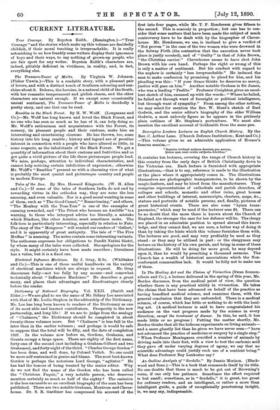Descriptive Lantern Lectures on English Church History. By the Rev.
C. Arthur Lane. (Church Defence Institution; Kent and Co.) —This volume gives us an admirable application of Horae,e'a famous maxim,— " Segnius irritant animus demises per aurent, Quern qua aunt oculis subjects fidelibus."
It contains ten lectures, covering the range of Church history in. this country from the early days of British Christianity down to the Victorian era. Each lecture is furnished with appropriate illustrations,—that is to say, reference is made to the illustration at the place where it appropriately comes in. The illustrations themselves are photographic transparencies, to be shown by the magic-lantern, and may be hired from the manufacturers. They comprise representations of cathedrals and parish churches, of colleges and schools, monastic and other ruins, great houses and other buildings of interest, manuscripts, charters, maps, &c., statues and portraits of notable persons, and, finally, pictures of great historical events. There are also some "hymn trans- parencies," which may be used if the lecturer sees fit. There can be no doubt that the more there is known about the Church of England, the stronger the case for her defence will be. The clergy are placed in an admirable position to spread abroad this know- ledge, and they cannot find, we are sure, a better way of doing it than by taking the hints which this volume furnishes them with. The lectures are good, and may very profitably be used as they stand : or they may be utilised in part : or the clergyman may lecture on the history of his own parish, and bring in some of these illustrations. He will be doing far more good, he may depend upon it, than he would by preaching a thousand sermons. The Church has a wealth of historical associations which the Non- conformist communities lack. It would be folly not to make use of them.
In The Healing Art and the Claims of Vivisection (Swan Sonnen- schein and Co.), a lecture delivered in the spring of this year, Mr. Berdoe discusses, from the medical point of view, the question whether there is any practical utility in vivisection. He takes the claims that have been advanced on behalf of the practice as having benefited medical science, and examines them, with the general conclusion that they are unfounded. There is a medical science, of course, which has little or nothing to do with the heal- ing art. (1 medical lecturer is said to have congratulated his audience on the vast progress made by the science in every direction, except the treatment of disease. In this, he said, it haa made little or no progress.) Putting the matter shortly, Mr. Berdoe thinks that all the hideous experiments on living animals— and a more ghastly list than he gives we have never seen—" have not advanced the practice of medicine or surgery by a single step." "When Professor Mantegazza crucified a number of animals by driving nails into their feet, with a view to test the carbonic acid they gave off under varying degrees of agony, we say that no scientific advantage could justify such use of a sentient being." What does Professor Ray Lankester say ?


































 Previous page
Previous page